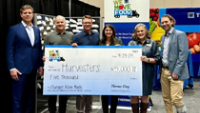Take What You Want, Eat What You Take

When our family gathers for the holidays, it’s a time we reflect fondly on memories of the past and amuse younger generations with what it was like “in our day.” As I began thinking about Thanksgiving this year, I was struck by the cultural shifts I’ve witnessed in my lifetime, especially around food.
Before the advent of social media and food bloggers, our relationship with food was largely shaped by those in our family. I vividly recall my mother repeating a phrase that greatly influenced me: “Take what you want, eat what you take.” A rather simple philosophy, these words reinforced how fortunate we were to have choices at mealtime and at the same time, be sure that we weren’t wasteful.
Today, entirely too much food goes to waste—nearly $200 billion dollars of food is thrown away in the U.S. each year – that’s equals about 150,000 tons each day, with fruits and vegetables being the most likely to be tossed away. The numbers are staggering, and many question whether we’ve reached the tipping point. Sadly, I’m not sure that we have.
The cultural shift we’re witnessing is driven in large part by a change in consumer expectations. Images of food and information is readily available at our fingertips. Our relationships and expectations now are being shaped by what we see virtually – aesthetically perfect food. The imperfect pear doesn’t make an appearance on Instagram or in grocery advertisements. As consumers, these images are reinforcing purchasing behaviors that impact retailers. When consumers expect unblemished, picture-perfect produce, retailers shift to only accepting cosmetically-ideal fruits and vegetables. Thus, the domino effect begins. What happens to the slightly blemished pear? It doesn’t make it to the shelves at your local grocer; it often goes to waste.
With an ever-growing number of families struggling with food insecurity, it’s time to make a change.
Change begins within each of us as individuals in how we think about the food we buy and the quantity of food we prepare each day. Will we “take what we want and eat what we take?” Change also needs to occur across government, industry and nonprofits where we all are working together to share resources, technology and expertise for the greater good.
Here at Thermo King, we are passionate about accelerating our efforts to end hunger. We recently expanded our We Move Food program to help recover and redirect more food that ultimately would go to waste. We continue to share our expertise, our time and our technology to help food banks nationwide build their transport refrigeration capacity to move more healthy, nutritious foods to families in need.
This Thanksgiving, as we gather with family and friends, may each of us “take what we want and eat what we take” and be reminded of our individual responsibilities to help reduce food waste and ultimately end hunger. Together, we can make a difference.


